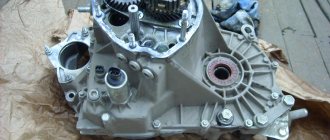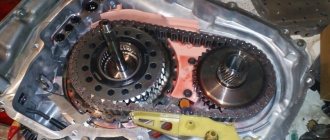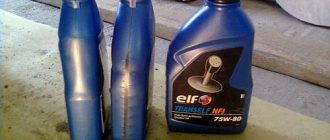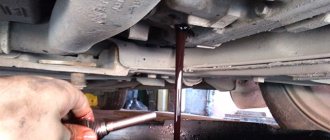If a person is not a very experienced driver and he has a vehicle with a manual transmission, then he often has a lot of questions about servicing his “iron horse”. One of these questions will be the following: rules for changing oil in a manual transmission.
In this article we will consider all issues related to this topic.
When is it necessary to change the oil in an automatic transmission?
Some car manufacturers position automatic transmissions in their models as maintenance-free. This means that the replacement of technical transmission fluid is not provided for according to the regulations and the box will last 150 thousand km, after which it will require a major overhaul, during which new oil will be filled. But from service practice it is clear that changing the oil in an automatic transmission after 50–80 thousand km extends the life of the unit to 200,000–250,000 km.
Condition of the technical fluid if it is not changed
Other car manufacturers directly indicate in the operating instructions that the transmission fluid needs to be changed every 60 thousand km. The following signs while driving may indicate the need for an unscheduled replacement:
- the box “kicks” when switching;
- there are significant delays when changing to an upshift or downshift;
- extraneous noise is heard from the automatic transmission (howling, knocking, humming);
- It is impossible to engage reverse gear.
To further determine the condition of the oil, you will need diagnostics to check its level and temperature, as well as the pressure in the box. The level is marked by a dipstick or control hole, and other parameters are indicated by special instruments.
If the color of the lubricant is dark, opaque and gives off a burning smell (friction discs burn), then an unscheduled oil change in the automatic transmission will be required, regardless of the distance traveled.
If you continue to operate with the old ATF fluid, the existing chips in the sump can get stuck in the valve body channels and damage the torque converter. This will disrupt the operation of the automatic transmission and the box will go into emergency mode. You will be able to continue driving only at low speed, or you will even have to call a tow truck. Overhauling an automatic transmission will require a lot of money. Alternatively, you will have to replace the complete unit. It is better not to let the car get into this state and perform maintenance on time.
Classification of transmission oils
Transmission oil is a lubricating fluid for gearboxes, created from petroleum products or synthesized chemicals with the addition of special functional additives (anti-scuff, anti-corrosion and anti-wear), which protects parts from wear and overheating.
The operating principle of transmission fluid is based on the creation of a special film that protects parts by covering them and protects them from harmful factors of complex operating parameters.
Preparation
You can change the oil at a service station or do it yourself. To change the oil in an automatic transmission yourself, you will need an inspection hole or overpass. You can ask a friend to go to his garage. Overpasses are often located near garage cooperatives, where a security guard will allow you to use it for a small fee.
Changing the oil in an automatic transmission involves removing the pan and filter. Some people wash the old filter in gasoline or kerosene and reuse it, but this should not be done.
Reduced filter capacity can lead to problems with the box. You can choose the right new filter based on the year of manufacture and make of the car. The manufacturer’s website also contains information about the automatic transmission itself (series, number), which will make the task easier (some Japanese or German-made gearboxes are installed on different brands of cars, so you can find a filter that suits your automatic transmission, although it is intended for a different car).
Need a new filter and gasket
In preparation, purchase a pan gasket. Surely the old one is already roughened or has cracks. When dismantling the pallet, it often breaks. A new gasket will ensure the housing is sealed and will eliminate ATP fluid leakage, leading to a drop in level. The drain plug has a copper washer, which often becomes deformed and worn off during operation. You also need to buy it to replace it. On the official website of the car manufacturer there are recommendations on which oil according to SAE viscosity to pour into the box and in what volume. Also take care of the keys for unscrewing the pan plug, dismantling the filter, removing the pan itself and the automatic transmission radiator pipes (the latter is needed if the complete replacement method is chosen).
How to drain oil from an automatic transmission
The main difficulty when changing ATF fluid in an automatic transmission is draining the waste. Unlike a manual transmission, there is a complex hydraulic unit with a torque converter, containing many narrow channels inside for oil circulation.
With most methods, it will be possible to drain the waste only partially, and only a complete hardware replacement will remove the old transmission fluid without any residue.
But, regardless of the chosen method, you will need to drain the waste from the pan. Let's consider the procedure and existing options.
Popular brands:
Hyundai Santa Fe, Mitsubishi Pajero, Skoda Octavia
Draining oil through the plug
The easiest way. If your car has a drain plug on the automatic transmission housing, then:
- Drive the car 5 km to warm up the engine and transmission.
- Place the car on a pit, overpass or lift.
- Prepare a bucket or cut canister with a capacity of at least 5 liters.
- Unscrew the drain plug with a wrench (usually a tetrahedron). Unscrew it further with your hands, holding it from the side and not from the bottom.
- Abruptly remove your hand with the stopper, exposing the container.
- When the waste has finished dripping, the old oil is considered almost drained - you will also need to dismantle the pan and filter.
Draining used oil through the drain hole
Draining oil through the dipstick
There are cars where the drain plug is not provided. Changing the oil in an automatic transmission is possible here by pumping out the old ATP through a channel with a dipstick. To do this, use a transparent tube from a dropper, purchased at a pharmacy. Remove the dipstick and insert the tube in its place. Lower it to the very bottom of the tray. Attach the free end from the outside to the syringe. The larger the capacity of the latter, the better.
Pumping out oil with a syringe
By extending the rod, a vacuum is created and ATF is pumped out of the pan. You need to act measuredly, since the mining is thick and moves slowly. To pump out 4 liters the process will need to be repeated about 30 times. To make the procedure easier, third-party manufacturers have developed a vacuum pump. It connects to the battery terminals and pumps old ATP from the sump through the dipstick hole into a substitute container. Everything happens quickly and easily, but you will have to spend money on equipment.
Pumping out used oil with a pump
Removing the box tray
Another way to change the oil in an automatic transmission is to remove the old one by immediately removing the pan with the filter. It's a dirty job, but it saves time. The heated car is placed on the pit and the bolts holding the automatic transmission pan are unscrewed. You will need to install a large basin at the bottom of the hole. First, a gap is created on one side of the body and the waste is drained from it. When it does not drip, the bolts are completely unscrewed and the pan with the remaining liquid is set aside. It contains a filter and a magnet that accumulates chips. The magnet is washed and the filter is replaced with a new one. Changing the oil in an automatic transmission is easier this way, since you don’t need to bother with a syringe and tube or buy a vacuum pump, but it’s impossible not to get dirty.
Removing the pan and filter
What and how much to fill
The table below will allow you to select oil by car brand and find out how much is required.
| Automobile | Oil | Volume (l) |
| AUDI | ||
| audi q7 (audi q7) | G052162A2, 4014835712317 Ravenol ATF 5/4 HP | 0,85 |
| BMW | ||
| BMW x5 e53 (bmw x5 e53) | BMW 83 22 9 407 858 "ATF D-III, ATS-500 83220397244 | 1 |
| BMW x5 e70 (bmw x5 e70) | 83 22 0 397 244, Multi DCTF, Motylgear 75W80 | 1 |
| BMW x3 e83 (bmw x3 e83) | 83229407858 | 1 |
| BMW x3 f25 (bmw x3 f25) | BMW Verteilergetriebe 4WD TF 0870 (83 22 0 397 244) | 0,6 |
| GAS | ||
| gas 66 | TAp-15V, TSp-15K, TSp-Mgip, 80W90 Gl-4 | 1,5 |
| GREAT WALL | ||
| Great wall hover | Dexron III | 1,6 |
| JEEP | ||
| Jeep Grand Cherokee | Mopar 05016796AC | 2 |
| INFINITI | ||
| Infiniti fx35 (Infiniti fx35) | Nissan Matic D - KE908-99931 | 2 |
| KAMAZ | ||
| KAMAZ 43118 | TSp-15K | 5,4 |
| KIA | ||
| Kia Sorento | Dexron II, III (IDEMITSU Multi ATF, GT ATF TYPE Multi Vehicle IV) | 2 |
| Kia Sorento 2 (kia sorento 2) | Castrol Syntrax Universal Plus 75W90, RAVENOL TGO 75W90 | 0,6 |
| Kia Sportage 1 | API GL-5 SAE 75W-90 | 1 |
| Kia Sportage 2 | 75W90 GL-5 (Mobil Mobilube HD 75W90 GL-5, Castrol 4008177071768 "Syntrax Longlife 75W-90) | 0,8 |
| Kia Sportage 3 | HYPOID GEAR OIL API GL-5, SAE 75W/90 | 0,6 |
| Kia Sorento TOD | Shell Spirax S4 ATF HDX, MOBIL ATF LT 71141 | 2 |
| Kia Sorento Part-Time | ATF Dexron III | 2 |
| RANGE ROVER | ||
| Land Rover Discovery 3 | SAF-XO 75W-90, Syntrax Longlife 75W-90 | 1,5 |
| Land Rover Discovery 4 | Tl7300-Shell Tf0753 | |
| Land Rover Freelander 2 | API GL5, SAE 90 | |
| Land Rover Defender | 75W-140 GL-5 | 2,3 |
| LEXUS | ||
| Lexus rx300/330 (Lexus rx300/330) | 85W-90, CASTROL TAF-X 75W-90 | 1 |
| MERCEDES | ||
| Mercedes GLK (Mercedes-Benz GLK-Class) | dispenser in a box | |
| Mercedes ml 163 (mercedes ml 163) | 236.13 #A001989230310, Motul Multi ATF | 2 |
| Mercedes w163 (Mercedes-Benz w163) | A 10 | 1,5 |
| Mercedes w164 (Mercedes-Benz w164) | A0019894503 | 0,5 |
| MAZDA | ||
| mazda cx 5 | GL-5 80W-90, MOBIL Mobilube HD 80w-90 GL-5 | 0,5 |
| mazda cx 7 | 80W90 API GL-4/GL-5 | 2 |
| MITSUBISHI | ||
| Mitsubishi Pajero Sport | Castrol TAF-X 75W-90 | 3 |
| Mitsubishi Outlander 3, xl (mitsubishi outlander 3, xl) | 80W90 GL-5, 75W90 GL-5 | 0,5 |
| mitsubishi l200 (mitsubishi l200) | GL-3 75W-85, GL-4 75W-85 | 2,5 |
| Mitsubishi Pajero 2 (mitsubishi pajero 2) | 75W85GL4 | 2,8 |
| Mitsubishi Pajero 3 (mitsubishi pajero 3) | GL-5 80W-90, Castrol Syntrans Transaxle 75W-90 | 3 |
| Mitsubishi Pajero 4 (mitsubishi pajero 4) | ENEOS GEAR GL-5 75W-90 | 2,8 |
| Mitsubishi Montero Sport | Castrol TAF-X 75W-90 | 3 |
| Mitsubishi Delica | 75W90 Gl-4 | 1,6 |
| NIVA | ||
| Niva 2121/21213/21214 (VAZ 2121/21213/21214) | Lukoil TM-5 (75W-90, 80W-90, 85W-90), TNK Trans Gipoid (80W-90), Shell Transaxle Oil (75W-90) | 0,8 |
| NISSAN | ||
| Nissan x trail t31 (nissan x trail t31) | Nissan Differential Fluid (KE907-99932), Castrol Syntrax universal plus 75w90 GL-4/GL-5 | 0,35 |
| Nissan Qashqai | NISSAN Differential Fluid SAE 80W-90 API GL-5 | 0,4 |
| Nissan Pathfinder r51 (Nissan Pathfinder r51) | Nissan Matic-D, Dexron III | 2,6 |
| Nissan Terrano | SAE75W90 GL-4, GL-5 | 2 |
| Nissan Teana | GL-5 80W90 | 0,38 |
| Nissan Murano z51 (Nissan murano z51) | Genuine NISSAN Differential Oil Hypoid SuperGL-5 80W-90 | 0,3 |
| OPEL | ||
| Opel Antara | GL-5 75W90 | 0,8 |
| Opel Mokka | GM 93165693, MOBILUBE 1 SHC 75W-90, Motul GEAR 300 75W-90 | 1 |
| PORSCHE | ||
| Porsche Cayenne Hang-on | Shell TF0870, RAVENOL Transfer Fluid TF-0870 | 0,9 |
| Porsche Cayenne Torsen | Castrol BOT 850, Burmah BOT 850 | 0,9 |
| RENAULT | ||
| Renault Duster 2.0 4x4 (renault duster 2.0 4x4) | Elf TransElf Type B 80W90 | 0,75 |
| Renault Koleos | Elf TransElf Type B 80W-90, Total Transmission rs fe 80w-90 | 1,5 |
| SUZUKI | ||
| Suzuki Escudo | SAE 75W-90, 80W-90 API GL-4 | 1,7 |
| Suzuki Grand Vitara | 75W-90 API GL-4, SAE 80W-90 API GL-5 | 1,6 |
| Suzuki CX4 | TAF-X | 0,6 |
| SSANGYONG | ||
| SsangYong Kyron (automatic transmission) | Dexron IID, III | 1,3 |
| SsangYong Kyron manual transmission | 80W90 API GL-4/GL-5 | 1,4 |
| SUBARU | ||
| Subaru Forester | no transfer case, reduction gear in the box | |
| TOYOTA | ||
| Toyota Hilux | API GL3 75W-90 | 1 |
| Toyota Land Cruiser Prado 120/150/200 | GL-5 75W90 Toyota Gear oil | 1,4 |
| toyota rav 4 | Toyota Synthetic Gear Oil API GL4/GL5, SAE 75W-90 | |
| Toyota Highlander | LT 75W-85 GL-5 TOYOTA | 0,5 |
| UAZ | ||
| UAZ Patriot | SAE 75W/90 according to API GL-3, TSp-15K, TAP-15V, TAD-17I | 0,7 |
| UAZ 469 | TAD-17, 80W90 Gl-5, 85W90 GL-5 | 0,7 |
| UAZ Hunter | SAE 75W/90 according to API GL-3 | 0,7 |
| URAL | ||
| Ural 4320 | TSp-15K | 3,5 |
| FORD | ||
| Ford explorer 2013 (ford explorer 2013) | Motul 75w140 | 0,4 |
| ford kuga | SAE 75W-90 | 0,5 |
| ford kuga 2 | SAE 75W140 | 0,4 |
| Ford Maverick | SAE 75W140 | 2 |
| Ford Explorer 5 | SAE 75W140 (Castrol Syntrax Limited Slip 75w140) | 0,4 |
| VOLKSWAGEN | ||
| Volkswagen Amarok | G052533A2, Castrol Transmax Z | 1,25 |
| Volkswagen Touareg | VAG G052515A2, Castrol Transmax Z | 0,85 |
| Volkswagen Tiguan | G 052 145 S2 | 1 |
| HYUNDAI | ||
| Hyundai ix35 (Hyundai ix35) | 75W90 | 1 |
| Hyundai Santa Fe 2.7 (Hyundai Santa Fe 2.7) | Shell Spirax AXME 75W90 | 1 |
| Hyundai Tucson | 80W90 GL-4/Gl-5 (Shell Spirax S3 AX 80W-90), 75W90 GL-5 (Сastrol Syntrax Universal 75W-90) | 0,8 |
| HONDA | ||
| Honda CR-V | transfer case combined with gearbox | |
| CHEVROLET | ||
| Chevrolet Niva | 80W-90 GL-4, 75W-90 | 0,8 |
| Chevrolet Captiva | GL-5 75W90 | 0,8 |
| Chevrolet Tahoe | Dexron VI (GM Dexron 6, Spirax S3 ATF MD3, Chevron ATF MD3, AC Delco auto trak II) | 2 |
| Chevrolet TrailBlazer | GM Auto-Trak II | 2 |
Oil change methods
Let's look at how to correctly change the oil in an automatic transmission, partially or completely, in what order the actions are performed and where to fill in the new fluid. Understanding the peculiarities of the process, it will be easier to decide whether to do the work yourself or contact a car service.
Partial oil change in automatic transmission: instructions
Modern automatic transmissions contain 6-8 liters of ATF, depending on the make and model. Partial replacement is considered a “refreshment” of the composition, since with this method it is possible to add only 30-40% of new transmission fluid. It's more affordable than a full replacement and takes about 60 minutes. But the effect does not last long - the procedure must be repeated every 15–20 thousand km.
Let's look at the procedure for changing the oil in an automatic transmission in step-by-step instructions:
- The engine starts and the car is driven for 10–20 minutes so that the internal combustion engine and gearbox reach operating temperature. This will help increase the fluidity of the lubricant.
- The car drives into a pit.
- The underbody protection is removed.
- Use a square wrench to unscrew the plug in the pan.
- Place a container and drain the old grease.
- The pan is dismantled and the old filter is removed from it. The magnet is cleaned.
- A new filter and gasket are installed. The pallet returns to its place.
- New ATF fluid is poured through the dipstick hole or breather to maintain atmospheric pressure. The level is set between the minimum and maximum marks.
After removal, the tray needs to be cleaned
Recommendations for car enthusiasts. To set the level correctly, you need to “drive” the box through all gears. This will fill the couplings with ATP fluid and expel the air.
The advantages of this method: you can do everything yourself, it will take 1 hour, a volume of 3-4 liters of transmission fluid for an automatic transmission is inexpensive. The disadvantages include: the need to repeat the process after 15,000 km, there may be delays during switching, hum, the life of the box is extended, but only slightly.
Removing the box tray
The second option of draining is more feasible with your own hands, but it already involves serious mechanical intervention - removing the automatic transmission pan. To do this, first, if there is one, remove the pan protection by unscrewing the bolts. Then unscrew the bolts of the box pallet itself, leaving two bolts in the corners at the end to make it easier to remove the pallet. Removed? – Drain the oil from the pan into a separate container and place it under the box - oil will continue to flow from there for some time. We recommend that you wash the tray. And yes, don’t forget to clean the magnets in it, because they catch metal particles from wearing mechanisms. Also, after removing the pan, it is recommended to replace its gasket, or apply a new sealant to the joint (if you decide to do this, do not rush to immediately fill in new oil - let the sealant dry).
After the automatic transmission oil stops draining, return the pan to its place and tighten the bolts. Here, again, you cannot do without some experience, since it is strongly recommended to tighten the bolts in a certain order with a special tool - a torque wrench. This is necessary to tighten the bolts with the same force so as not to damage the threads and the structure of the pallet itself.
In this case, this is also very important - if your transmission does not have a dipstick or control tube (as on ZF gearboxes on BMW or Land Rover, for example), then when changing the oil by removing the pan, you need to accurately calculate the amount of oil drained in order to fill it later as many. Otherwise, you will have to set the fluid level, guided by the control tube - a kind of replacement for the automatic transmission dipstick. To do this, the box must be warmed up to 30-40 degrees, which is measured by reading data from the car’s electronics. This is necessary for accurately setting the level of ATP liquid, since it has different densities at different temperatures, and therefore occupies different volumes in the unit.
After this, ATP fluid is added to the transmission until this fluid flows out of the control hole - this means that the required fluid level in the box has been reached - no more, no less. However, we recommend entrusting such a difficult procedure to experienced professionals.
Complete automatic transmission oil change: instructions
It is possible to completely replace the transmission fluid, but this is a more expensive process. But it gives a significant improvement in the operation of the box. Let's look at how ATP changes using hardware and manual methods to choose the appropriate option.
Method No. 1
This method is suitable for self-replacement in a garage with a pit. Everything is done as in the situation described above: the old lubricant is drained, the pan is cleaned, a new filter and gasket are installed, and fresh ATP is filled in according to the level. After driving about 200 km in normal operation, the procedure is repeated (the filter and gasket no longer need to be changed, but only washed and cleaned).
Since when draining by gravity or sucking with a syringe, it is possible to extract about 40% of the lubricant from the automatic transmission, adding fresh transmission fluid to the level only dilutes the composition. At the first change, the ratio of new and old oil in the box is 40/60%. When replacing again - approximately 70/30%. With the third - 85-90/15-10%. Replacements are not performed more than three times in a row - it is not financially feasible.
The advantages of the method include:
- the ability to do everything yourself in a garage;
- no expensive equipment required;
- You only need to pay for ATP (the filter and pan seal are purchased once for the first replacement).
But this method is time-consuming - every 200 km you will have to remove the underbody protection, drain the used lubricant, and fill in new one. Not everyone has the time to do this type of maintenance every week. 100% replacement is not possible. Therefore, let's consider other methods.
Method No. 2
A complete automatic transmission oil change with your own hands is possible if you use the pressure in the box to pump out waste. To do this, all actions are performed as in the case of a partial replacement (draining, replacing the filter and cleaning the pan). Then fresh ATF is poured into the box to the very top (until it flows out of the filler hole). The supply and return lines are disconnected from the transmission cooling radiator and the ends of the hose are lowered into a container (12 liter basin, bucket, etc.).
Connection diagram of the automatic transmission to the cooling radiator
The engine starts and the pressure in the box begins to build up and the transmission fluid begins to circulate. With this method, waste is forced out of the torque converter and valve body naturally. When about 4 liters have drained, turn off the engine and add more fresh ATP. The engine starts again and the system continues to bleed. Noticing the light color of the lubricant at the output, the process stops. All that remains is to attach the hoses to the radiator pipes, set the level and drive the car in different modes for the test.
With this method, natural circulation in the unit is used to pump the system without the help of additional equipment. You will only have to pay for consumables and the volume of technical fluid - 7-9 liters. The entire procedure is carried out in one go - there is no need to perform repairs every week. But there are also disadvantages: the operation is quite complicated and scary for a beginner - you can do something wrong and damage the node.
The most common mistake is the ATF level in the pan being too low, which leads to air being sucked in and running dry.
This can damage the clutch pack, planetary gear or torque converter. Repairs will be expensive.
Method No. 3
The most effective way is hardware replacement. This is the displacement of old lubricant by pumping new lubricant through the system under pressure from a special station. The automatic transmission oil change scheme using modern equipment looks like this:
- The car is driven onto a lift, where the protection is dismantled and the waste is drained.
- The pan is removed, cleaned and a new gasket with filter is installed. Everything returns to its place.
- The supply and return pipes of the radiator of the box are unscrewed.
- They are connected to hoses from the station, which is already filled with 10–12 liters of new ATP.
- The engine starts and the device begins to supply fresh transmission fluid to the box. The hydraulic unit pumps it and it comes out through the pipe, but instead of the radiator it ends up outside and drains into a receiving container.
- Through the transparent tube you can see what color the liquid is. When it becomes identical to the new lubricant, the process is stopped and the level is set.
Hardware oil change in automatic transmission
The good thing about this method is that it provides 100% replacement through displacement. The torque converter and valve body are washed. The quality of service can be seen immediately by the color of the lubricant pouring out. Transmission performance improves: it becomes quieter, shifts faster, and the ride becomes smoother. Drivers note a reduction in fuel consumption. But there are also disadvantages: you will need a large volume of 11–12 liters of transmission fluid, half of which is spent simply on flushing. The replacement device is expensive and not available in every service station, not to mention garage workshops. In some unscrupulous car service centers, they may take 12 liters of technical fluid, but fill only 6 liters, appropriating the rest for themselves. Sometimes they forget to install a filter or replace the gasket.
Recommendations for car enthusiasts. To check the quality of a complete replacement, ask to be present during the service - normal service stations will not refuse this. Also drop a little ATF from the dipstick onto the paper - the new one will be red, and the old one will be black or cloudy.
Useful tips
Before starting to operate the vehicle, it is recommended to carry out a visual inspection of the vehicle and the parking area. If drips and oil stains are found on the floor under the bottom, you need to check the oil level in the manual transmission. Even a small decrease in oil volume can lead to intense wear of the gears, followed by serious repairs to the transmission and the vehicle as a whole.
One of the basic rules for changing oils and operating manual transmissions is that timely installation of new gaskets and oil seals instead of worn ones can help eliminate oil loss, and also prevent breakdowns and wear of gears.
Each car shows different results for the oil filled. For some, only synthetics are needed, while others work fine with cheap mineral water. Most often, drivers choose the golden mean: semi-synthetics. The most important condition is maintaining stability of operation, as well as the technical and operational characteristics of the vehicle over a long period.
Replacement at a service station
Service stations practice partial replacement and complete renewal of the composition of the ATP transmission fluid, which is chosen by the client himself. As a rule, high-quality lubricants of different viscosities are already available, so you only need to bring a filter to your car model. But some services also have consumables for popular car brands in stock in order to save car owners’ time as much as possible.
If the client chooses the partial method, then the waste is removed through the drain hole (if provided by the car manufacturer) or pumped out through the dipstick.
When completely updating the composition with washing, modern equipment is used. They are universal and suitable for all car models. Some are equipped with very simple controls with start and stop buttons. The quality of washing is determined by a fragment of a transparent tube attached to the front panel of the stand.
Other versions of service equipment are equipped with a screen and programs for each make and model of car. They are programmed with the volume of lubricant and other operating parameters that ensure the highest quality replacement of the technical fluid in the box. Bench displacement is considered the best today for servicing automatic transmissions. With it, the resource of the node is extended to 200–250 thousand km. The procedure takes 2–3 hours, but it will need to be done once every 50,000–60,000 km.
How to add oil to an automatic transmission
You can add fresh ATP fluid during a partial change or to achieve the desired mark after a complete update in several ways, depending on the design features of the automatic transmission.
Fill the oil through the dipstick
The simplest method, since most cars with automatic transmission have a dipstick. You will need a flexible hose from a medical IV and a funnel attached to its other end. All actions are performed from above in the engine compartment.
Through the breather
The pressure control valve can also be used to supply fluid to the automatic transmission. You will need a flexible hose with a diameter of 8–10 mm and a funnel. You won't be able to fill it directly because wires and other parts in the engine compartment get in the way.
Automatic transmission breather
Pumping oil from below through the control
There is a bolt on the side of the automatic transmission housing that plugs the inspection hole. This is one way to set the level in models without a dipstick. After unscrewing it, ATF fluid is supplied through the hose with a large syringe. Work is carried out from below from the inspection hole.
Changing the oil in the automatic transmission extends the life of the key component of the car. If there is no time and money, a partial update of the composition is performed. But it is better to perform a hardware shake with flushing to avoid costly repairs of the automatic transmission in the future.
Recommendations from experienced car enthusiasts and mechanics
Compliance with the automatic transmission oil renewal interval will extend the operating life of the unit, save on repairs and drive with a smooth transmission. To save money, you can service the box yourself if you follow the manufacturer's instructions.
It is correct to drain and fill the automatic transmission oil after warming up the box and checking the level. You cannot mix different ATFs, just like you cannot add motor oils, antifreeze, or kerosene. In order for the unit with the new fluid to switch without jerking, you need to reset the adaptation.
After traveling over 120 thousand km, only batch changes of automatic transmission oil are permissible. Chips, friction dust, oxides and clots of the liquid itself settle on the oil filter. When replacing a hardware transmission in an automatic transmission, auto mechanics do not always warn about the need to install new consumables. And also, not every box can withstand washing with chemical compounds.











